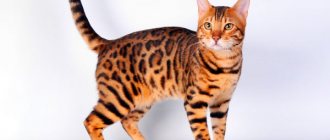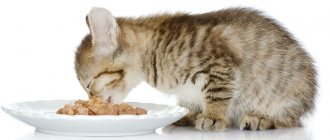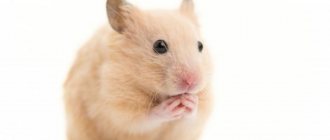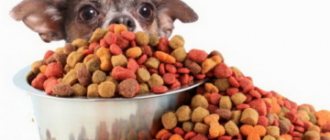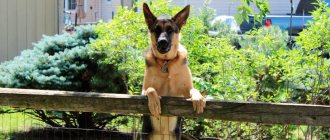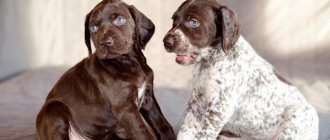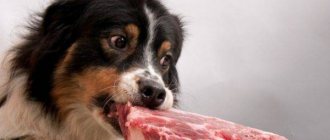- September 15, 2018
- Dogs and hunting with them
- Natali Michaelis
Laika is one of the most striking hunting dog breeds. This animal has extraordinary endurance and strength despite its relatively small size. Cops are characterized by a high level of intelligence, quick reaction, playful disposition and passion. The four-legged hunter is able to tune in to the same wavelength as his owner. The structure of the coat allows these dogs to be bred in almost any climate zone. Read our article about what to feed your husky puppy and how to care for him. The information is also diluted with a large number of photographs of these cute animals, which will allow you to have a correct idea of their appearance.
What to feed your husky
Since this breed is a cop, the owners, first of all, want their dogs to develop good physical shape and great endurance. To obtain such qualities, it is necessary to create a correct and balanced diet. Remember that while hunting, pets expend a huge amount of calories, so do not forget to feed your pet properly upon returning from the forest.
What to feed your husky at home? The diet must be formulated in such a way that the animal can cope with heavy physical activity. It is necessary to prepare a young body for such training in advance, but only an adult dog can show the best results. It is preferable to give your puppy natural food rather than prepared food. For example, fresh meat and fish will provide the animal’s body with a huge amount of protein and vitamins. Let's look at each of the diet items in more detail.
Choosing a puppy feeding method
There are fundamentally three different positions on what to feed a husky puppy:
There are three ways to feed a puppy: dry food, natural food, mixed food.
- The first is feeding with ready-made industrial food. It's easy - just pour the food out of the pack, and if the puppy is less than two months old, then soak it. It already contains minerals and vitamins. If the food is of high quality, then it is well balanced.
- The second group of Laika owners prefers to feed their puppies natural food: meat, milk and cereal. This is quite difficult - because you need to prepare it specially for the dog. Of course, you can give your puppy leftover food from your table, but we discussed above why this is absolutely forbidden.
- The third position on feeding is mixed. Often dog breeders prefer it. Very young puppies are given meat and cereals as complementary food. And when the puppy grows a little, dry food is added. In the future, dry food is left for the puppy throughout the day and as a treat during training.
Selection of ready-made food
Based on quality and price, all ready-made feeds are divided into four groups:
- Economy class includes the well-known Pedigree, Chappi, Darling, Purina One, Darsi. These foods contain poor quality ingredients, very little meat, and a lot of soy and flavorings. It is very difficult for a puppy to get enough of this food, as it is of low nutritional value.
- Premium class is better than economy. These are ProPlan, Dog Chow, Gemon, Brit Premium, and some Happy Dog foods. These foods already contain more meat than economical ones, but there are still a lot of flavors, and they contain soy as a protein substitute.
- Super-premium class is Brit Care, Monge, Eukanuba, Hills, 1st choice, Animonda, Bosch, Almo Nature, Happy Dog. The composition of such food is excellent: a lot of good meat, high-quality cereals, no soy.
- Holistics are modern food Acana, Farmina, Now, GO! They do not contain flavorings or soy. These foods contain the highest percentage of meat, and all ingredients are high-quality and proven. On the day of this food, a Laika puppy needs very little food, because it is very filling.
Feeding with natural food
Many owners choose to feed their puppy regular food. At the same time, proportionality should be observed and diet diversity should be maintained.
A husky puppy's diet should include the following foods: meat and fish, cereals, vegetables, dairy products.
Meat and fish. Husky puppies are fed beef, veal, chicken, rabbit, turkey, and sea fish. First they give it in the form of minced meat, gradually making the pieces larger. After a month, by-products are added several times - liver, lungs. The fish must be boiled and rolled to remove the bones. It is not recommended to give pork, lamb, and fatty poultry to your husky puppy.
Dairy products. This is the most important source of calcium and must be present in a husky puppy’s diet. First, puppies begin to receive boiled cow's milk diluted with water. Then, gradually, whole. Usually puppies drink milk and eat cottage cheese without any problems.
Cereals. Cereals are added to a small puppy in the form of liquid milk porridges. Gradually the porridge cooks more and more thickly. After 1.5 months, the puppy can cook thick porridge in meat broth with the addition of eggs.
Vegetables. Usually puppies are not too fond of vegetables and fruits, so we add them to the meat porridge in the form of puree.
Important! Even the most balanced menu may be accompanied by a lack of some elements, because husky puppies have very fast growing bodies. Therefore, do not forget to add mineral and vitamin supplements.
Recipes for a husky puppy
Meat and vegetables must be added to the porridge for a husky puppy.
Buckwheat porridge with meat broth. Meat - beef, chicken - wash and boil. After that, we take out a piece of meat, and pour buckwheat into the pan in a ratio of 1 to 2 (for 1 glass of buckwheat, two glasses of broth). Cook for 25 minutes or leave the boiling broth to steep overnight. The meat can be cut into small pieces and added to the porridge.
Rice porridge with meat and vegetables. Boil rice according to the recipe above. Instead of meat, you can use offal (chicken stomachs). Add finely chopped meat (stomachs) and grated carrots to the finished rice in the ratio: 40% meat, 40% rice, 20% carrots.
Hercules porridge with egg. Boil rolled oats in milk - 2 cups of milk 2.5% for 1 glass of rolled oats. Cool, add chicken egg.
Meat
This product is recommended to be given raw or slightly frozen. In this case, it is worth giving preference to low-fat varieties. Meat is the basis of the entire diet, so its quality must be high. Tubular bones and fatty pork are contraindicated for representatives of this breed. It is also undesirable to feed your four-legged friend boiled meat products, since they lose most of the beneficial microelements during the cooking process.
It is advisable to include in the diet meat on the bone, which contains tendons and a little film. Such products are much better for dogs than regular tenderloin. To prevent infection by parasites, it is recommended to scald meat with boiling water or immerse it in boiling water for 2-3 minutes. Be sure to cool the product before giving it to your husky, otherwise the dog may burn its tongue.
Fish
This product should be included in the diet one to two times a week. It is best to give preference to representatives of the Salmon family. Such fish contains enough fatty acids that will give the dog energy for hunting and an active lifestyle. It is also worth noting that fish significantly improves the quality of animal fur, so it is worth including it in the diet unconditionally. However, it is better to refrain from freshwater representatives, namely: crucian carp, roach, perch, tench, and so on. Such fish will be too fatty for huskies.
What to feed a month old husky puppy
As soon as your baby turns 30 days old, you can begin to gradually introduce him to solid food. If the little husky stops feeding on its mother's milk by this time, it is necessary to include cow's milk in its diet. The temperature of the product should be slightly warm - about 20 degrees Celsius. You can also add 1 teaspoon of honey and raw egg yolk (per 1 liter) to fresh milk. Instead of milk, you can use 1.5% kefir.
During the second meal, it is recommended to feed the puppy cottage cheese or cottage cheese. For lunch, you can also give your baby milk porridge of medium consistency. Rolled oats cooked in meat broth will be a fairly nutritious dish.
What to feed a 1 month old Husky puppy for dinner? You can prepare some dish consisting of fruits and vegetables mixed with sour cream or vegetable oil. For this salad, apples, pumpkin, beets, carrots or cabbage are usually used. All ingredients must be served raw. You can also serve finely chopped boiled meat for dinner. Some veterinarians recommend adding mineral supplements to such food, observing the dosage standards indicated on the packaging of the drug, although such actions are not at all necessary.
All of the above diets are suitable for babies whose age does not exceed two months. Feeding your husky puppy should be done in small portions 5 to 6 times a day. Additionally, it is recommended to add a pinch of bone meal, a drop of fish oil or powdered eggshells to the food. Also remember that your pet should not be overfed, since excess weight can lead to curvature of the spine or paws. At a young age, your puppy's bones are still developing, and under the weight of a full stomach, they will begin to grow abnormally.
Approximate feeding schedule by month
Such instructions will allow you to correctly calculate how to feed your pet.
To get carbohydrates you need to feed your pet cereals
Feeding a puppy at 1-3 months
An important role is played not only by what to feed a Laika dog at 1 month, but also how. For such a baby, 7 meals a day are required. The diet should include the following products:
- soup;
- minced meat with vegetables;
- cottage cheese;
- boiled eggs;
- porridge.
Feeding a husky for 2 months corresponds to the nutrition of a month-old animal.
A slightly different diet for a 3-month-old pet. He should eat the following foods:
Feeding a puppy at 1-3 months
- milk – 750 ml;
- cereal – 200 g;
- meat – 300g;
- vegetables – 100g;
- fish – 400 g.
3-month-old dogs should receive food throughout the day in 6 meals.
Baby's nutrition plan at 4-5 months
At this stage, the need for milk decreases, but the amount of meat consumed should be increased. The diet is something like this:
- meat – 400 g;
- dairy products – 500 g;
- fish – 500 g;
- vegetables – 200 g;
- cereals – 300 g.
Baby's diet at 4-5 months
The number of meals during this period is 4.
Diet for husky puppies over 6 months
For adult dogs, you can replace milk with yogurt and cottage cheese. During this period, meat and dairy products should be given equally - 0.5 kg per day. If you do not plan to feed the animal meat on a specific day, you can give 600 g of fish. As for the norms for consuming cereals and vegetables, they are 500 and 200 g, respectively.
Rules for feeding two-month-old puppies
Have you thought about how to feed a husky puppy from 2 months and up? It is worth noting that not only the development of the dog, but also its life expectancy depends on a well-organized process. This procedure should be approached wisely if you want to show yourself as a caring and loving owner.
What to feed a two-month-old husky puppy? A young hunter needs to be accustomed to adult food over time, gradually introducing into the diet those dishes that we talked about at the beginning of the article. However, a properly balanced diet is only part of caring for your pet. It is also necessary to follow the basic rules of feeding a young husky.
Basic rules for feeding husky puppies
The owner of the puppy must understand that he should be taught to feed himself. This is an important step, which is why some inexperienced dog owners find it difficult.
The owner of the puppy must understand that he should be taught to feed himself
First, you must find out how and what you fed your one-month-old husky before you acquired it, and feed it the same way for the first time. Do not force the animal to suddenly switch to another food - this will leave a mark on its health and development. Ensure a smooth transition.
Advertising:
Feeding the husky after weaning from natural maternal feeding should include boiled cow's milk. In dogs it is richer, so to bring the milk to the desired consistency, add a little sugar and cream.
Plate holder
It is recommended to purchase a special stand for the bowl from which your four-legged friend will eat from your nearest pet store. An alternative to factory models is an ordinary children's stool, which is just the right height for a two-month-old puppy. However, do not forget to make a small depression in the middle of such a device so that the animal does not accidentally knock over the bowl during the meal.
The bowl should be placed at the level of the dog's chest. A different position may lead to deterioration of the young hunter’s posture. If necessary, file the legs of the chair with a hacksaw, but remember that the stand should not wobble or fall. When the puppy grows up a little, you can place a wooden plank under the high chair.
Meal frequency
Depending on the age of the puppy, feeding should be done at a certain interval. This feature of care is due to the fact that small dogs spend a lot of energy on walks and games, so they need to be fed more often. For an adult, it is enough to eat twice a day to replenish the calories lost. The frequency of feeding babies is:
- up to two months – 6 times a day;
- from 2 to 4 months – 5 times;
- from 4 to 6 months – 4 times;
- from six months to a year – 3 times a day.
However, do not forget that with increasing age and decreasing number of feedings, the volume of portions increases. For example, a one-year-old husky should eat the same amount of food per day as its six-month-old counterpart. Food must be given on a strict schedule. Lunch occurs approximately one and a half to two hours before walking.
CARE AND FEEDING (KARELO-FINNISH LAYKA) FINNISH SPITES
- 1. ALL ABOUT THE BREED
- Advantages of the breed
- Origin of the breed
- Character and temperament of the Finnish Spitz
- Video for a novice hunter-dog breeder
- Breed standard
- 2. (KARELO-FINNISH LAYKA) FINNISH SPITCH IN THE APARTMENT
- 3. HOW TO CHOOSE A PUPPY?
- 4. CARE AND FEEDING (KARELO-FINNISH LAYKA) FINNISH SPITCH
- 5. WHAT TO NAME A PUPPY?
- 6. (KARELO-FINNISH LAYKA) FINNISH SPITES AROUND THE WORLD
Feeding, basic food, diet.
Newborn Karelian-Finnish Laika puppies feed on their mother’s milk for up to 1-2 months. But already at the age of 3 weeks, the breeder begins to feed the puppies additionally, so that by one and a half months the puppy is completely independent and can completely manage without its mother. At this point it usually passes to the new owner. The food of a very small puppy should be soft. This is mainly raw meat and cottage cheese, which are given in small portions of 50-70 g, but quite often. Many owners begin to wonder what it’s like to feed a puppy raw meat. Raw meat is much softer and easier for a dog’s stomach to digest than boiled meat, which also contains almost no vitamins. Those who are afraid of bacteria and worms should simply freeze and then defrost the meat, but under no circumstances cook it. You can give any meat, from poultry to beef, lamb, except pork. As for the bones, they are given later; these can be soft cartilage, large brain bones, small chicken bones (feet, necks, etc.), but it is not recommended to give tubular chicken drumstick bones.
I would also like to give advice to porridge lovers. From cereals you can give buckwheat, wheat, millet, rice porridge. But you should always remember that 25% of the porridge should be 75% meat, and not the other way around. If feeding a dog (formerly a predator) consists of nothing but porridge and water, the result will certainly affect the bones, development, power and endurance of the future dog. It is recommended to give not dairy, but fermented milk products in: kefir, cottage cheese. Milk is not digested in the stomach of a puppy and dog, and comes out empty, also causing the proliferation of various pathogenic bacteria in the stomach and intestines. Therefore, the most ideal feeding option would be low-fat cottage cheese. You can also give low-fat sour cream. Vitamin-rich foods include fruits - apples, peaches, apricots, dried fruits; vegetables - carrots, cabbage, bell peppers, zucchini, eggplant. Among vegetables, carrots are especially useful, whole or grated with olive oil. Giving butter is strictly not recommended, as it is too harmful to the dog’s liver. It is better to give a piece of cheese as a reward. Avoid eating cottage cheese, cheese and dairy products that contain palm oil.
It is better not to give boiled meat, sausages, sausages at all, or to give them only as a reward for some kind of “combat” merit.
Dry food is not the best way to feed a hunting dog, since it is a small dog with a perfect metabolism, and it needs very small amounts of nutrients. Dry food is a highly concentrated mixture of synthetic vitamins, minerals, fats, proteins, etc. In general, dry food is preferable for large dogs, whose stomach volume allows them to digest the entire mass of food swollen inside. The stomach of hunting Karelian-Finnish huskies is small, and leftover food can clog the channels of the excretory system - the ureters, kidneys and other organs. Very often, a dog overeats dry food, since the composition contains strong flavors that affect the brain, and the dog can eat it without measure. This can be compared to fast food for a person, where the same cravings are present regardless of hunger. Therefore, it is better to give dry food occasionally or for reward and only of the “Premium” class. Such dry food usually costs much more than meat. Water should always be in your dog's bowl. This generally accepted rule should not always be followed for Karelian-Finnish Laikas. Since they are hyperactive dogs, they often “whip” water out of nothing to do, resulting in complete puddles in the apartment. There are times when they deliberately spill a bowl of water left behind. In such cases, water should be given from time to time, in doses. As for food, uneaten food should be removed after 10-20 minutes if the puppy refuses to eat. Under no circumstances should you offer alternative food if the puppy refuses the original one. Perhaps he is not hungry. But laying out several dishes for him to choose from will form the habit of being capricious in food, which will be inconvenient in the future, and generally should not be characteristic of a hunting dog. According to the feeding regimen for a puppy, you need to adhere to 3-4 times in small portions; as they grow older, the number of times decreases and the portions increase. After a year, it is enough to feed an adult dog 1-2 times a day, giving a total of 200-300 g of meat/bones. So, let's sum it up in a quick guide to puppy/dog products. Recommended:
beef, lamb, elk, any lean meat, poultry, cottage cheese, vegetables, fruits, dried fruits, rye bread crackers.
Recommended in small quantities:
cheese, olive oil.
Not recommended:
tubular chicken bones, any boiled bones, boiled meat, sausages, flour, etc.
Strongly not recommended:
milk, butter, sweets and other grocery products, boiled tubular drumstick bones.
Vaccination.
In order for the puppy to have full contact with other dogs and the external environment in the future, it is necessary to follow the vaccination schedule.
What diseases are most common at the moment? Of the complex of 5, 7 or 8 vaccines, the most common and most dangerous infectious disease is parvovirus enteritis. Plague and leptospirosis are not so common, and the benefits of the other components in the complex are generally questionable. In any case, they don’t make a vaccine against parvovirus separately, as in the old days, so we choose the minimum complex and start vaccinating. Before vaccination, it is necessary to undergo deworming or simply “drive away the worms.” You don’t need to contact your veterinarian for this; you can choose the best medicine yourself. At the moment, veterinary pharmacies sell special deworming products for puppies; they are mild and gentle. You should not use strong and strong products (from 100 types of bacteria or 500 types of helminths); after all, your puppy was not born in a landfill, so ordinary products will suit him. Attention! Deworming medications that are too strong can be toxic to a small puppy and lead to irreversible consequences, including death. So, we usually follow the following schedule: 1) first deworming in 30 days. In this case, it is necessary to correctly calculate the dose by weight. A puppy at this age weighs about 1 kg. 2) The second deworming is 2 weeks after the first, you can do it with a different means to be on the safe side. 3) Vaccination with a 2-3-valent vaccine, which must include plague and enteritis, because these are the infections that are deadly for a small puppy. 4) Revaccination. Depending on the vaccine, it can be carried out after 14, 21 days or a month. 14 days after revaccination, the puppy can safely contact the external environment, walk, play with other dogs, and visit dog parks. It is better to get a rabies vaccination at 6-7 months, when the process of changing teeth is completely over, since vaccination at an early age is dangerous for the puppy’s health. Vaccinations do not guarantee one hundred percent that your puppy will not get sick with one or another disease, so there is no need to test the puppy’s immunity by hypothermia , overwork it, weaken the body in other ways. It is also necessary to say a few words about anti-mite treatment. The tick in Russia becomes active with the first thawed patches, this is somewhere around the beginning of March and until November. But the peak of its activity occurs in May and August, mid-summer June-July - it is practically absent, in other periods it is not so active, but we must not forget that the risk of a tick bite and infection with piroplasmosis is always there during the period from March to November. In this regard, we can recommend using drops on the withers while simultaneously using some kind of anti-tick spray. The use of anti-tick tablets internally is not recommended, as it poisons the dog’s blood, which can then be poisoned with the blood of the tick. Such a chain is not justified from the point of view of the dog’s health. Constantly wearing collars is also harmful. During summer periods, you can only use a spray to give your dog’s body a break from chemicals. Care and education.
The dog is distinguished by the absence of a specific odor; its coat always has a natural shine and an attractive red color. It does not require any special care other than brushing to remove old fur. But, nevertheless, our advice is to periodically wash the dog, since old hair is difficult to remove from dry skin, only with softened water. Thus, you can wash your dog 1-2 times a year. The Karelo-Finnish husky can withstand frost well, but the dog’s home should have a draft-free kennel with straw bedding. If the dog wants to hide from the rain or wind, he will always have the opportunity to do so. The dogs live successfully in Yakutia, where the temperature is sometimes below minus 50. The Karelo-Finnish Laika is a very active, temperamental and very hardy dog, it is created for movement and heavy loads. Therefore, long walks in the forest are as important to her as food and drink.
Hunting training
It is worth noting that not every husky puppy can be taught hunting skills. In order to determine whether your dog is suitable as a cop, you need to observe its habits and disposition, especially in relation to fresh tracks of other animals. If the dog is indifferent to them, then he will not become a hunter. However, if your four-legged friend is constantly sniffing at them, it would be advisable to conduct several training sessions to teach hunting wisdom.
The optimal age for becoming familiar with the character and disposition of an animal is 10 months. At this time, you can go into the forest with your dog and see what object he chooses for hunting. It is desirable that the vegetation in this forest be relatively low.
The training process involves several tricks, as a result of which the animal will learn to be an obedient companion and an intelligent watchman. First, you will need to accustom your pet to the forest in order to develop the hunter's instinct in him. Don't spare your personal time and let the puppy run around the forest to his heart's content. He must sniff and examine all the places that interest him. As a result of various canine techniques, you can teach a dog:
- detain large prey in one place;
- distract the attention of predators from the owner;
- to attack the trail of this or that prey;
- scare wild birds by raising them on the wing.
As a rule, the husky quickly gets used to hunting certain game. It will not be difficult for such a dog to catch a hare, squirrel or marten. Don't forget to praise your dog for any success he achieves. It is necessary to make it clear to the cop that her actions are correct. Only in this case will you be able to raise a faithful assistant and a good hunter.
We hope our article helped you better understand what to feed your husky puppy. Remember that the diet should consist only of natural products, and not prepared foods. Also, you should not overfeed a young dog if you want to raise him to be a hunting assistant and not a couch potato.
